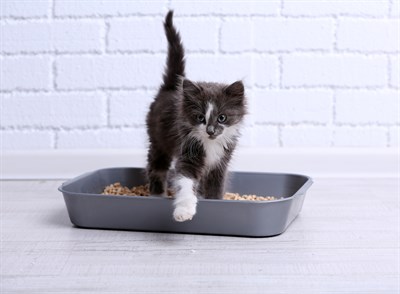Potty Training Your New Pet

The day your new puppy first sees its new home is a special day for any new pet owner. Playing with them, caring for them, and watching them explore every room of their new home is heartwarming and fun. Regrettably, many people forget that cleaning up your little bundle of fur’s mess in your home is a responsibility that can quickly become irritating. That is why it is crucial to have a potty-training plan ready for your new pet as soon as you bring them home.
“It’s important to start young with potty training, because what we don’t want to do is establish bad habits in our pets,” said Dr. Mark Stickney, Clinical Associate Professor at the Texas A&M College of Veterinary Medicine & Biomedical Sciences. “Once they learn one way to do something it’s hard for them to unlearn it, and any change can confuse them.”
“Begin training your dog as soon as you bring it home,” said Stickney. “Take it straight outside and give it plenty of time to go potty. Stay out there with it, but ignore it until it is done. Then, as soon as it is done, give it a treat and ‘ooh and ahh’ over it.”
While this progression may be irritating and time-consuming, it will be well worthwhile when you no longer have to pick up messes inside your house.
When your pet is inside the house, one of the most effective ways to train it is by crate training.
“When you are not at home you should keep your pet in a crate inside your house,” said Stickney. “This becomes their safe place, or den, and thus crate training takes advantage of their natural instinct not to make a mess in their own den.”
As soon as your home instantly take your pet out of its crate and outside to do its business.
“It’s not realistic to leave a puppy in a carrier for eight hours straight and not have an accident,” said Stickney. “If at all possible you should try to come home or arrange for someone to come by and give it a potty break in the middle of the day if you work full-time.”
It is important to never use your pet’s crate as punishment. Your pet sees the crate as its safe-place, and if they are put in one as punishment the pet will develop a negative view of it and will no longer see it as their den.
“This also goes for punishment of accidents. Never negatively reinforce their behavior,” said Stickney. “If you swat or scold them when they have an accident they not only don’t connect their accident to the punishment, but it can cause anxiety and lead to slower potty training.”
If you have followed these training recommendations and are still ineffective, there are professional dog trainers who can help with the development. You should also check with your veterinarian to make sure the animal does not have an underlying problem.
Potty training is significantly different for cats and dogs. While dogs need time attention to train, cats are quite a bit easier.
“Litter training is instinctive for cats,” said Stickney. “All you really need to do is put your kitten in the room with the litter pan and keep it in there when you are not playing with it or paying attention to it.”
While there are a number of diverse litter-boxes available for your kitten, the most important aspect to look for, at least initially, is that your kitten is comfortable and can easily get in and out.
“You have to remember that when you bring home a kitten it is just a little baby, and if you get a really high box it may have trouble getting into the box and therefore will not use it,” said Stickney. “It’s also good to remove anything in the room that may resemble litter such as potted plants, or they may become your pet’s bathroom.”
When choosing a litter for your box it is important to remember that, while there are many varieties available, they are mostly marketed for human preferences. Find one that your cat will use and that works for you as well.
“Although all cat-litter brands are ok to use it may helpful if you know what kind of litter your kitten was using before it came to live with you and start with that if possible,” said Stickney. “Cats can be texture and odor specific with their litter so if you start with that you can gradually transition them to another litter later if you prefer.”
“If your dog or cat is already housebroken and suddenly starts having accidents it may be a sign that it has a health problem,” said Stickney. “In this case you should definitely take the pet to its veterinarian for a check-up.”
No one wants to deal with pet messes in their home. If you have a potty training plan in place and are adamant about it, you can have both a healthy, happy and potty-trained pet and a clean, fresh smelling home.
Pet Talk is a service of the College of Veterinary Medicine & Biomedical Sciences, Texas A&M University. Stories can be viewed on the Web at vetmed.tamu.edu/news/pet-talk. Suggestions for future topics may be directed to editor@cvm.tamu.edu.


